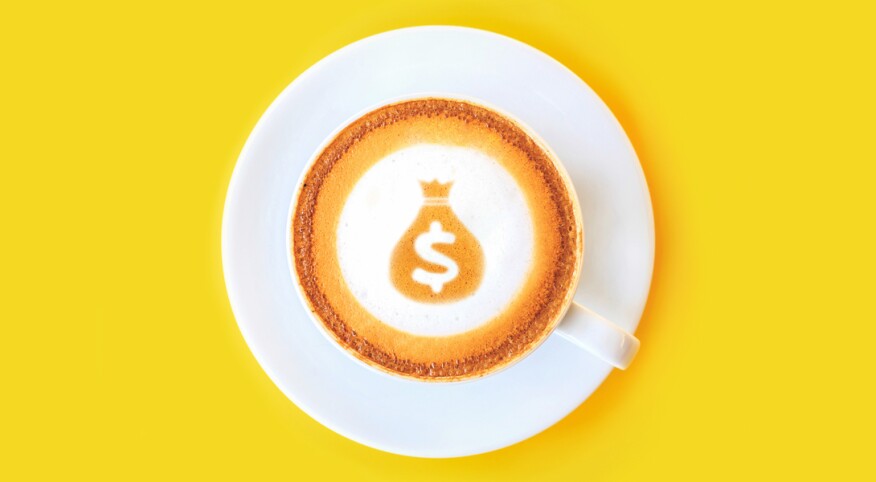If you’re a boomer, a new survey says that you could be wasting $683 of your hard-earned cash every month. You may be squandering $588 every month if you’re Gen X, and millenials are reportedly splashing out on a whopping $838 worth of Netflix, Peloton and Anthropologie. But before I tell you where your money is going, let me confess where mine went.
Up until a few weeks ago, I spent about $40 on paper cups, plates, small dishes and bowls every single month. That’s nearly $500 a year! After I went back to work full time, my family used them for weekday meals, avoiding squabbles over whose turn it was to load the dishwasher. I rationalized those discretionary purchases in the name of life balance and family harmony, choosing to be present for the kids and to start the day positively, with minimal “a.m. mayhem.”
You see, my long commute gets me home after dinner, when our teens are busy making school lunches, showering and then getting ready for bed. And my husband doesn’t deserve to come home to a sinkful of smelly dishes. Of course, our sons have chores: laundry, trash, cleaning and hauling groceries from the car. But they also have daily music and sports practice, plus loads of homework. Dishwashing was nobody’s job. So it was outsourced to those nice folks at Dixie, who saved my sanity until the weekend, when I’d make a nice dinner, break out the “good” china and set a proper table.
But that changed with the reality of a family first: The boys will attend a parochial school next term. Now, I was raised by a public school teacher, and my hubs and I went to public schools. Nobody on either side of our family has ever paid a nickel for primary or secondary education. But things change and parochial school is the right decision for right now. So, with the sticker shock of tuition for twins looming, we’re all busting suds and cutting back on spending. And to my surprise, there isn’t that much squabbling.
The Twelve Spending Traps
This is a judgment-free zone, so let’s get real about the small fortune – averaging $697 – that, according to financial services company TD Ameritrade, you may be frittering away each month. Keep in mind that that’s an average of investors polled. I’ve got fam living on Social Security, for which monthly payments to retirees averaged $1,422 last year. There’s no way anybody on that tight a budget is blowing nearly half of that on nonessentials. But whether we find $697 of potential savings or $69.70, that’s still real money we can use to build wealth.
What you need to know is that between the budget categories we call fixed costs (mortgage, a car note) and those we call variable expenses (groceries, clothing) is a whole ‘nother gray area we refer to as “the basics.” When the company asked respondents which items would be “hard” or “impossible” to live without, they found (and I’m creatively paraphrasing) …
1. Vacation/travel: 60% said “tough”; 21% “impossible”
2. Coffee: 39% said “ouch!”; 12% “hell naw!”
3. Gifts for family/friends: 32% said “I have a big heart”; 11% “I won’t be cruel”
4. Technology/electronics: 40% said “it relaxes me”; 11% “you’ll pry my phone out of my cold, dead hands”
5. Dining/takeout: 49% said “Not my turn to cook”; 9% “I’ll starve!”
You get the idea. For Gen X-ers, vacations and dining out are big basics. Same for millenials, who are also hooked on gym memberships and streaming services. Boomers? Besides dining and trips, you like giving gifts. And you’ve gotta have your coffee.
What about spending traps number 6 through 12? Other nonessentials some of us call basics are entertainment, hobbies, memberships, home decor, occasional spa services (hello!), cosmetic enhancements (hair, nails, etc., NOT a Brazilian butt job!) and expensive clothing and accessories.
Could you live a month without one of your basics? Twenty-two percent of Americans say no — and nearly half of us say our retirement savings are taking a hit because of stuff we buy that “serves a purpose” or “makes me happy.” Almost half of Gen X-ers and a quarter of boomers say nonessential spending has impacted their credit card debt. “Out of all generations, boomers admit they are least likely to last one month without spending money on nonessentials,” Dara Luber, senior manager for retirement at TD Ameritrade, told AARP.
Now get ready to be really shocked.
I certainly was when I moseyed on over to this investment return calculator on aarp.org. Whelp, if I were to stash my monthly $40 paper plate savings into a tax-deferred investment (that’s a 401(k), y’all) earning six percent annually for 20 years, I’d have $18,354 extra to retire on. (That’s without adjusting for inflation and assuming I invest the money in one shot each year.)
That’s $18,354. From paper plates!
Go ahead and try it with the cost of your gel nails, silk press, car washes or a month’s worth of mocha lattes.
Eye popping, right?
Now let’s run that average $697 in nonessential spending through the same investment calculator and see what happens: A cushy $319,820 nest egg, before taxes.
The takeaway? As we periodically review our finances, let’s take an even closer look at our “must haves.” Maybe chose one or two to give up for a month. The following month, we can pick different ones. Because, let’s face it, a comfortable retirement is the real “must have.”

Getty Images










